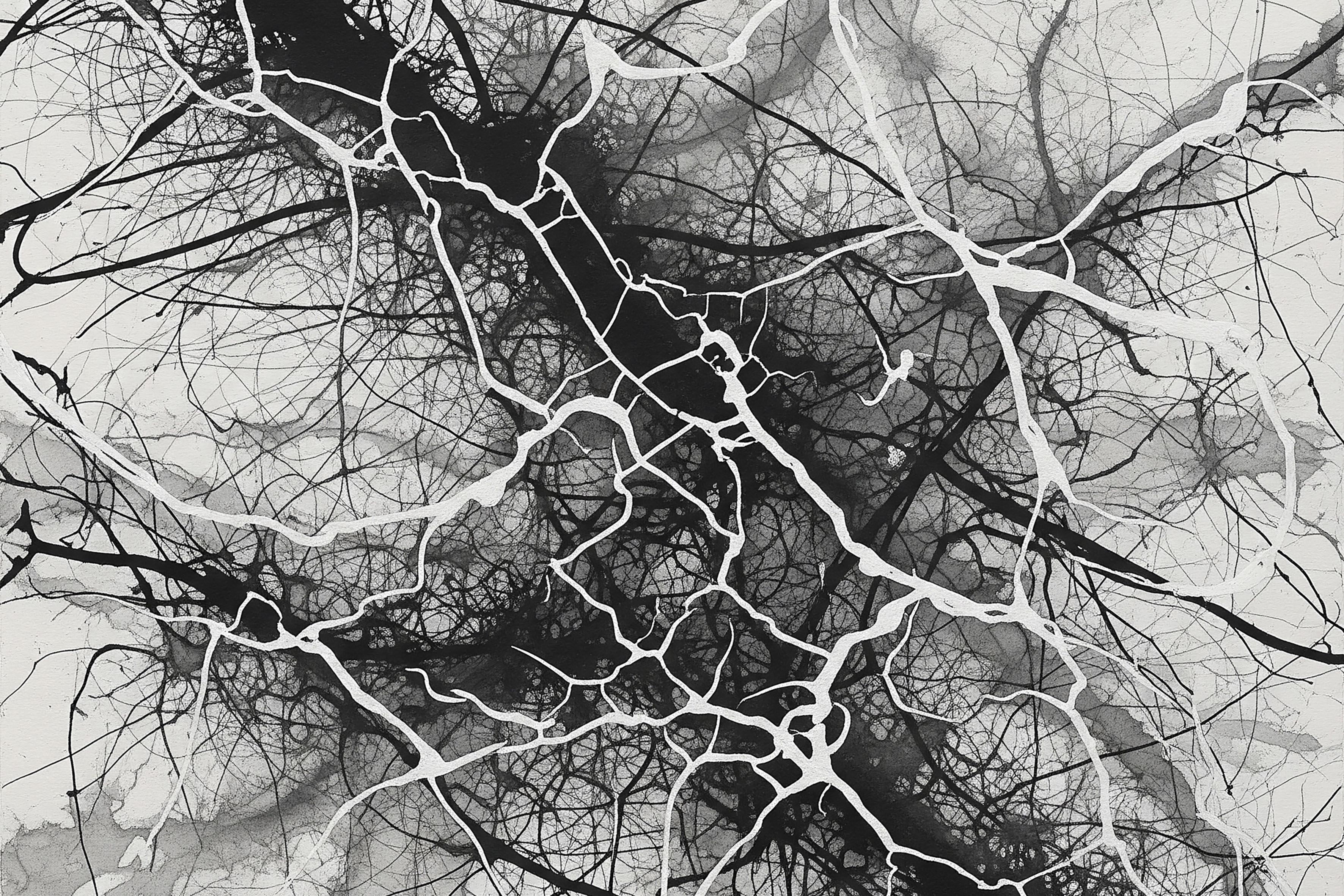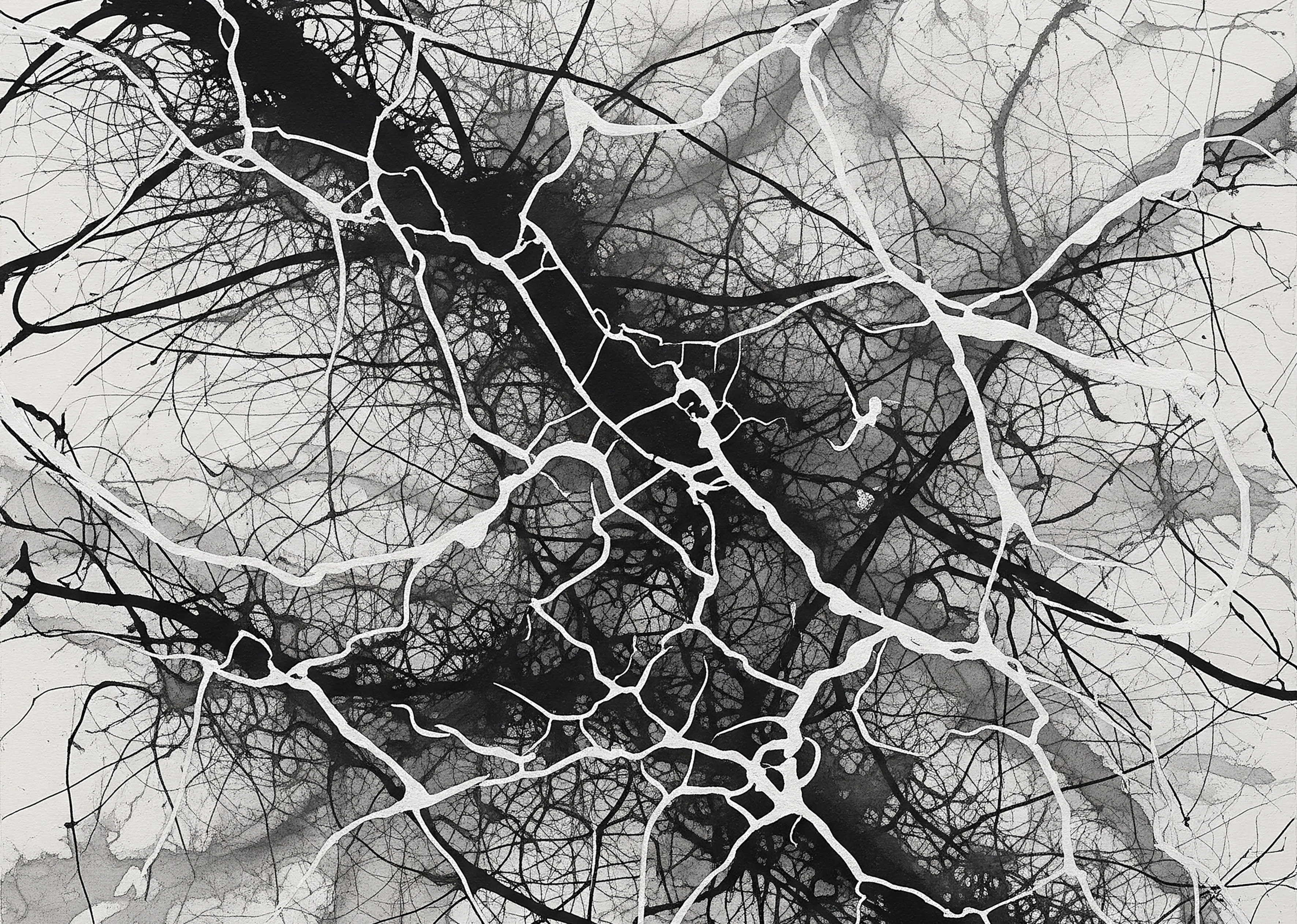
現成品與個體化——超脫「視網膜性」的書寫|文:清水 穰
レディメイドと個体化 ― 非「網膜的」な書のために|清水 穣
Ready-made and Individualization. For a non-“retinal” Calligraphy|Minoru Shimizu
———
「網膜的」とはマルセル・デュシャンの用語で、網膜に映るあらゆる見かけの美しさを指す。その反対語が「灰色の物質(脳細胞のこと)」で、デュシャンにとって芸術の本当の役割は網膜ではなく知性を刺激することにあった。さて、ここに1つの抽象書がある。「地球規模で広がる温暖化と乾燥化を、ヒビ状の神経質な線で表現し、全体としては枯れた根を意識して造形した。わたしたちの未来はどうなるのかという不安をにじみで表現した」とある。
「視網膜性」一詞是馬塞爾・杜象(Marcel Duchamp)所使用的術語,指的是映射於視網膜上的一切外在美感。與之相對的概念是「灰色物質」(即腦細胞),對杜象而言,藝術真正的任務並非取悅視覺,而是激發知性。那麼,現在眼前有一件抽象書法作品(如下圖)。作品解說道:
「以裂紋般神經質的線條,表現出蔓延全球的暖化與乾燥現象,整體造形的意象是來自於枯萎的植物根部,以墨的暈染呈現對我們未來將會如何的焦慮。」
“Retinal” is a term coined by Marcel Duchamp, referring to all apparent beauty perceived by the retina. Its antonym is “gray matter” (meaning brain cells), for Duchamp thought that art's real purpose was not to stimulate the eyes, but the intellect.
Now, here is a piece of abstract calligraphy. The artist’s statement says: Global warming and aridification spreading worldwide are expressed through crack-like, frail lines, while the overall form evokes withered roots. The anxiety over what our future holds is subtly conveyed through the ink bleed.

もちろん、網膜的な作品だ。一見コンセプチュアルなステイトメントは、線や滲みからの連想の範囲内に収まっている。既視感があるのも当然で、抽象書の美、つまり書という芸術において文字ではなく筆致と筆触の力強さや墨の滲みの美しさ、図像と余白の関係といった、構成美・絵画美を評価する美意識は、すでに70年以上も前のものである。当時、東洋の書と西洋の現代美術はどちらも抽象的な線の芸術として交流した。それが唯一の前例となったからなのか、近年アートフェアで見かける現代書の多くが、いまだにこのスタイルを採用している。墨美のダイナミズム、それは、書の近代史に無知な一般人にとって「芸術的な書」のステレオタイプなのである。とはいえ現在(2025年)の現代美術の一端を担う書が、70年前のステレオタイプだとは、なんとも寂しい話ではないか。ちなみに、上の画像の作者は人工知能である。
這當然是一件所謂的「視網膜性」的作品。乍看之下,這個解說似乎煞有其概念性,但其實僅停留在觀看時對線條與墨暈所產生的聯想。當然探討所謂的「既視感」是無可厚非的。所謂「抽象書法」之美 —— 也就是在書法藝術中,不以文字為中心,而重視筆勢、筆觸的力度與墨暈的美感,以及圖像與餘白之間構成的平衡與畫面之美 —— 這種審美意識,早在七十多年前就已經形成。當時,東方的書法與西方的現代美術,正是以「抽象的線條藝術」這樣的共通語言進行交流。或許正因為那是唯一的先例,近年在藝術博覽會上見到的許多現代書法作品,依然沿用這種概念。墨的動感與美感,對於不了解書法近代史的大眾而言,這已然是對「藝術性書法」最典型的刻板概念。然而,當今(2025年)被視為現代藝術一部分的「書法」,若其認知還停留在七十年前的舊觀念中,不免令人感到惋惜與寂寞。順帶一提,剛剛那張圖的作者其實是AI。
Of course, it's a retinal work. The seemingly conceptual statement remains within the realm of associations derived from lines and smudges. It's only natural to feel a sense of déjà vu, for the aesthetic appreciation of abstract calligraphy —that is, the appreciation of compositional beauty and pictorial beauty in the art of calligraphy, focusing not on the characters themselves but on the power of brushstrokes, the beauty of ink diffusion, and the relationship between imagery and negative space— dates back over 70 years. At that time, Eastern calligraphy and Western modern art interacted as abstract line-based arts. Perhaps because it became the only precedent, many contemporary calligraphy pieces seen at art fairs in recent years still adopt this style. The dynamism of calligraphic brushstrokes is, for the public ignorant of the modern history of calligraphy, the stereotype of “artistic calligraphy.” It's too bad that calligraphy, which is considered part of contemporary art today (2025), is based on a stereotype from 70 years ago. The image above was created by artificial intelligence.
———
そもそも、墨美は何のためにあるのか。
追根究底而言,墨之美究竟是為了什麼而存在的呢?
What is the purpose of the beauty of ink, after all?
———
まず認識しておくべきは、言語がレディメイドだということである。われわれは、生まれ落ちてすぐに、すでに存在し話されている言語を与えられ刷り込まれる。言語とはつねにすでに他者の言語なのである。言うまでもなく書は文字の芸術であるが、文字こそはレディメイドであり、宗教や政治の支配を根源で支える権力の象徴であった。数千年にわたって墨美を培ってきた伝統書は、権力の象徴でありレディメイドである文字を、個体化(個人化ではなく)してきたと言える。個体化とは、レディメイドに一回かぎりの反復不能性を与えることである。書道史を彩る様々な書法は、そのための方法であった。そのとき文字書はもはや権力の行使ではなく、そこからの解放をも意味したであろう。書の天才たちのほとんどが、権力と政治の世界から身を引いた人間であることは、偶然ではない。
首先必須認識到的一點是:語言本身就是一種「現成品(ready-made)」。從出生起,我們被灌輸的語言是早已被廣泛使用的存在。因此,所謂的「語言」,始終是「他人的」。毋庸贅言,書法是一種文字的藝術;然而文字本身正是一種「現成品」,原屬於權力的象徵,也是宗教與政治能支配大眾所依存的根本。在漫長的數千年中,培育出「墨之美」的傳統書藝,可以說正是將作為權力象徵、將「現成品」的文字進行「個體化」(而非「個人化」)的歷程。所謂「個體化」,是指將「現成品的文字」轉變為一次性的且不可重複的存在。書法史上林立的各種字體與風格,正是為達成此目的的途徑。於是,書寫文字不再是權力的行使,而成為從權力之中獲得解放的象徵。縱觀書法史上造詣上極高的人大多數選擇遠離權力與政治世界,這樣的現象也並非偶然。
First, we must recognize that language is ready-made. We are born into a language that already exists and is spoken, and it is imprinted upon us. Language is always already the language of others. Needless to say, calligraphy is the art of writing characters. Writing itself is a symbol of power that is closely tied to religion and politics. Traditional calligraphy, which has cultivated the beauty of ink over thousands of years, can be said to have individualized (not personalized) characters that were ready-made symbols of power. Individualization is the act of endowing ready-made objects with a singular, irreproducible quality. The diverse calligraphic styles that adorn the history of calligraphy were methods employed to achieve this. Then, calligraphy no longer signified the exercise of power, but rather liberation from it. It is no coincidence that most of the geniuses of calligraphy were individuals who had withdrawn from the world of power and politics.
———
近代の抽象書は、50年代の欧米抽象絵画の影響下に、この墨美の伝統的な機能 ―個体化と自由― だけを純粋抽出しようとしたのだと見なせる。しかし先に述べたように、文字の意味を失った書は、不可避的に網膜的なレトリックへと流れ、画一的なステレオタイプになってしまった。古典書の墨美はいまも変わらず新鮮であるが、現代の書は、それとは異なる方法で、レディメイドの個体化という伝統書の本質を受け継がなければならない。山本尚志が見出した方法は「命名」であった。
因此,近代的抽象書法可以說是受到1950年代歐美抽象繪畫的影響,試圖純粹地提煉出「墨之美」傳統書法中所具有的兩項功能——個體化與自由。然而,正如前文所述,書法一旦脫離文字本身的意義,便不可避免地淪為「視網膜性」的作品——最終變成一種千篇一律的刻板形式。古典書法中的「墨之美」至今依然清新而動人,但現代書法必須以不同於過去的方式,去繼承「將現成之物個體化」這一傳統書藝的核心本質。而山本尚志所發現、並付諸實踐的方法,正是——「命名」。
Modern abstract calligraphy can be seen as an attempt, under the influence of 1950s Western abstract painting, to extract purely the traditional functions of ink art—individualization and freedom. However, as mentioned earlier, calligraphy that has abandoned its characters inevitably flows into retinal rhetoric, becoming a uniform stereotype. The ink beauty of classical calligraphy remains as fresh as ever, yet modern calligraphy must inherit the essence of traditional writing —the individualization of ready-made forms— through a different method. The approach discovered by Yamamoto Hisashi was “naming.”
———
山本は長年にわたって井上有一に私淑し、その上で、有一以降の書道を考える運動「ART SHODO CONTEMPORARY」を展開中である。有一は漢字の記号性を図像性の方向へ押し戻していき、文字でなく絵でもない臨界点をトリミングした。しかしそこで文字が獲得した変形の多くは擬人化(例えば「貧」)であって、古の甲骨文字の、図像から記号が現れ始めているその姿の衝撃に比べれば、あまりにも人間的であった。
山本尚志長年以井上有一為師,並在此基礎上,展開探討「井上有一之後的書法」——「ART SHODO CONTEMPORARY(當代藝術書)」這項運動。井上一方面將漢字中的「符號性」導向「圖像性」,試圖將書寫出來的作品推向既非文字、亦非繪畫的臨界點。然而,經由這樣變形所產生的形態,大多有擬人化的傾向(如「貧」字的例子),與上古甲骨文字中「符號初現於圖像」那種原始的震撼相比,仍顯得過於擬人化。
Yamamoto has long admired Yuichi Inoue as a mentor, and based on that foundation, he is currently developing the movement “Art Shodo Contemporary,” which contemplates calligraphy beyond Yuichi. Yuichi pushed the symbolic nature of the kanji-character back toward its pictoriality, focusing on the critical point that it was neither a character nor an image. However, many of the changes the characters went through were overly human (for example, “Poverty”), especially when compared to the ancient oracle bone script, where meaningful characters first appeared from pictographs.
———
山本の書は、ピクトグラム(例えば雲形)にその名称(クモ・くも・雲・KUMO)を上書きするものである。ただし、そのピクトグラムは往々にして恣意的で、何を表すかが判らないばかりか、与えられる意味ともほとんど対応しない。命名の力によってのみ、それは「ゲーム」や「くも」、「虎」や「UFO」に成る。別の言い方をすれば、全く同じピクトグラムでも、別々に命名されうる。これは、同じ物体に、別々の名前を書きつけることと同じである。つまり、山本の書は、恣意的に描かれた対象を、命名することを通じて個体化している。「マシーン」と書かれた書が100点あれば、それは100個の新しい個体である。任意の形態のピクトグラムを、山本は任意の普通名詞でもって名付けるであろう。それはすべての普通名詞を固有名詞と化すこと、レディメイドの世界を個体化することであり、すなわち世界を一つの固有名において生きる、われわれの生にほかならない。
山本的書法,是在圖像符號(例如雲的形狀)之上,疊加其名稱(如日文中「クモ」「くも」「雲」「KUMO」)的書寫。而這個圖像符號往往是極其隨興的——不僅難以辨識其所指為何,甚至與名稱之間沒有相呼應的關係。因為唯有藉由這種「命名」的力量,它們才得以成為「遊戲(ゲーム)」、「雲(くも)」、「虎」或「UFO」。換言之,即便是完全相同的圖像符號,也能被賦予不同的名稱。就如同在同一個物體上,寫上不同的名字一般。也就是說,山本的書,正是透過對任意描繪之對象的「命名」行為,來實現其個體化。如果有一百件題名為「マシーン(機械)」的作品,那便是誕生了一百個嶄新的個體。山本會以任意的普通名詞,去為任意形態的圖像符號命名。這正意味著,將一切普通名詞轉化為固有名詞,使「現成品的世界」重新獲得個體性——在山本的作品中,我們能否超越現成之物的世界,於個體化的存在中,重新書寫「活著」本身。
Yamamoto's calligraphy involves overwriting pictograms (such as cloud shapes) with their names (with Kanji, Hiragana, Katakana and alphabet). However, these pictograms are often arbitrary, not only unclear in meaning but also barely corresponding to the meanings assigned to them. Only through the power of naming do they become “game,” “cloud,” “tiger,” or “UFO.” In other words, even identical pictograms can be named differently. This is equivalent to labeling the same object with different names. Yamamoto's calligraphy individualizes arbitrarily depicted subjects through naming. If there are 100 pieces of calligraphy inscribed with “machine,” they are 100 new individual machines. Yamamoto would name pictograms of any form using any common noun. It is to transform all common nouns into proper nouns, to individualize the ready-made world—that is, to live the world with a single proper name, which is none other than our very existence.
———
(註1)
「レディメイド」もデュシャンの用語の1つだが、ここでは「すでに作られてあるもの」で、商品ではない「既製物」の意味で用いている。
「現成品(Readymade)」一詞同樣出自馬塞爾・杜象(Marcel Duchamp)的術語。不過此處所指的「レディメイド」,並非商品意義上的「製成品」,而是指「已被製作出、既已存在之物」(既製物)。編按:「Readymade」最早由杜象於1913年前後提出,指將日常現成物(如小便池、腳踏車輪等)脫離其原有用途,置入藝術語境中,使之成為藝術作品的行為。清水穰在此文中則擴大其意義,用以指涉「任何已存在、非創造的事物」,特別是語言與文字作為社會中早已被製造並使用的「既製物」。
“Ready-made” is also one of Duchamp's terms, but here it is used to mean “something already made,” referring to “ready-made objects” that are not commodities.
(註2)
Google Geminiを使用。与えたキーワードは「抽象画」「ひび割れ」「墨」「神経質な線」「ふるえ」。
圖片產出使用了 Google Gemini(人工智慧生成工具)。所輸入的關鍵詞為:「抽象畫」、「裂紋」、「墨」、「神經質的線條」、「顫動」。
Using Google Gemini. The keywords provided were “abstract painting,” “cracks,” “ink,” “nervous lines,” and “trembling.”
(註3)
日本語は、漢字から派生した3種の文字 ―漢字、草書から生まれたひらがな、漢字の断片であるカタカナ― に加え、近代ではアルファベットをも用いるので、ピクトグラム(意味を担った絵記号)との命名関係は、それぞれの文字が派生してきた歴史的背景に応じて、4つのバリエーションをもつだろう。
日語的書寫體系由漢字所衍生出的三種文字——漢字、自草書演化而成的平假名、以及作為漢字片段的片假名——所構成;此外,自近代以降,又引入了拉丁字母(alphabet)的使用。因此,日語中的文字與「象形符號」(pictogram,即承載意義的圖像記號)之間的命名關係,將會依據各種文字所出現與演化的歷史脈絡,形成四種不同的變體形式。補充:清水穰在此指出,日本語書寫系統的複合性——同時涵蓋了表意(漢字)、音節(平假名/片假名)與音素(拉丁字母)三層結構——使得「文字與圖像」之間的命名邏輯呈現多重關係。這一點為山本尚志的作品提供了語言學與符號學層面的背景,說明其「命名」行為如何在不同文字系統間游移,生成異質的表意空間。
Japanese employs three types of characters derived from kanji—kanji itself, hiragana born from cursive script, and katakana, which consists of kanji fragments—along with the alphabet in modern times. Therefore, the naming relationship with pictograms (pictorial symbols bearing meaning) likely exhibits four variations, corresponding to the historical background from which each character evolved.
///
Related Exhibition:

